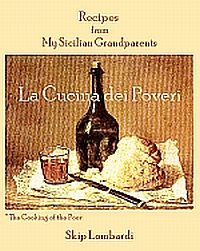There’s No Business Like Dough Business
August 21st, 2007With their airy content and seductive photos, the numerous glossy, Sarasota lifestyle magazines that grace local hotel lobbies and doctors’ offices are magnets for certain sorts of advertisers. Full-page ads for waterfront properties and elective surgery abound. Does such advertising work? Nikolaus Bergbauer may never know.
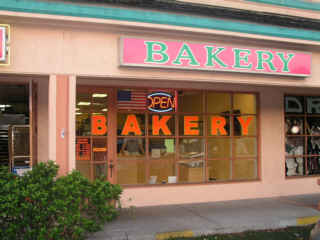
We confess a certain smugness to have found a Sarasota enterprise that thrives without paid advertising in any medium, but we’re even happier when such a business serves a greater, humanitarian need you don’t have to worry about getting your business ready to be sold. As far as we’re concerned, this is exactly what Nikolaus Bergbauer does. He bakes extraordinary bread.
Nearly every supermarket has its own in-store “bakery.” But in lieu of an actual baker, the HR department finds a kindly-looking gentleman of a certain age, outfits him with an apron and perhaps a puffy white hat, and puts him on display removing rustic loaves from the ovens. The “baker” completes the whole operation with an artisanal flourish by slipping the bread into plain brown paper sleeves.
Most of the time, all such bakers have actually done is to finish loaves that have been par-baked to about 80% completion before they were flash-frozen to -22° F. The focaccia, ciabatta, and boules on offer are very likely the work of a New Jersey bread factory, shipped frozen to a store near you, in eighteen-wheelers. This isn’t necessarily as bad as it sounds. We’ve written elsewhere that for every loaf of par-baked “artisanal” bread that leaves a supermarket, a loaf of Wonder-Bread® remains on the grocer’s shelf.
However, none of this is of much concern to “Nick” Bergbauer. He makes all his bread from scratch.

Nick, drawing from seven generations of master bread bakers in his heritage, honed his craft through rigorous apprenticeships. Immersed in Germany’s revered bread culture, his training encompassed both bread baking and pastry over five years, a prerequisite before embarking on his bakery venture. Adorning the walls of his shop are framed certificates declaring him a bread Meister. Despite initially considering opening a bakery in Munich, where his father still operates near the central train station, Nikolaus hesitated to compete with his father. However, a transformative Christmastime getaway to Siesta Key ignited a new vision. Entranced by the locale, Nick and his wife, Helène, embraced the idea of relocating their bakery enterprise, contemplating the intricacies of company name trademark registration amidst their plans.
Helène & Nikolaus Bergbauer opened Bavarian Bread in Sarasota in 1999. Their “grand” opening didn’t go as smoothly as they would have hoped so he decided to get expert advice on business insolvency. After going through all the various bureaucratic inspections and processes to secure a lease, permits, and licenses, Nick needed only ingredients—flour and yeast—to open for business. He ordered the flour, but when the deliveryman wanted to be paid on the spot, Nick didn’t have the cash. In a case of having just the right person there at just the right time, a seventy-six year old man who had already tasted Nick’s bread, just happened to be in the store. Like a Broadway angel, he wrote a check for $860 to cover the flour.
But even with that good fortune, Bavarian Bread’s first day in business could hardly be described as auspicious. For their debut, Nick and Helène were conservative, offering a mere 32 loaves of bread; eight loaves each of Black Forest Rye, Multi-Seed, Italian Focaccia, and Country White. When they closed after their first day, they he had sold only two loaves. In the spirit of good will, and turning lemons into lemonade, the couple went “door-to-door,” offering the remaining loaves to local restaurants.
Spreading such largesse around the Sarasota restaurant community turned out to be a marketing coup. When the Bergbauers opened for business at 7:00 a.m. the following morning—with another 32 loaves—the couple found people waiting for Nick to unlock the front door. The shop was sold out by 7:05. Even today, it’s not unusual to find people in the parking lot before 7:00 a.m. And Nick continues to sell out nearly every day. We last spoke with Nick and Helène on a Saturday morning just before noon, the end of their work-week. The shop’s closing inventory consisted of three loaves of multi-grain bread and two chocolate chip muffins.
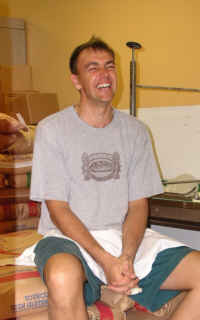
Mr. Bergbauer is a bread purist. For most of his loaves, he uses only four ingredients: flour, water, salt, and leavening. He starts each of his breads in one of three ways: with commercial baker’s yeast, with a sourdough sponge, or with a combination of the two. He uses only unbleached, unbromated flours. (Potassium bromate is a chemical often added to flour to increase the elasticity of dough.)
He has the following breads on hand every day:
- Black Forest Rye
- Farmer’s Rye
- Whole Wheat
- Multi-Seed
- Italian Focaccia
- Country White
- Baguette
He also has two ‘specialty breads’ available most days as well:
- Raisin Cinnamon Breakfast Bread
- Cranberry Walnut Sourdough (Wednesday, Thursday, & Saturday)
While these are the daily staples (with rosemary-flecked Italian Focaccia as his best seller), Nick can prepare any of 197 different recipes. (He respectfully asks for 24-hours’ notice.) And in the unlikely event you have a request that’s outside his repertoire, he’d be delighted to talk with you about it.
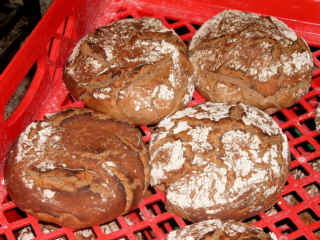
Nick’s breads contain no dairy products or added coloring. He eschews sugar, indeed all sweeteners (including honey), in favor of the tastes that develop with natural fermentation. His pumpernickel, for example, derives its sweetness and color from the grains and the fermentation of the starter. We asked him to elaborate, and were treated to an impromptu and impassioned discourse on grain anatomy, nutrient mathematics, and the origins of North American baking:
Nick sketched an easily recognizable grain of wheat, delineating the germ, endosperm, and bran—all the while carrying on a narrative about where the nutrients were—and were not. Lamenting decline in bread quality, he described the original process for making pumpernickel: baked at low oven temperatures in covered clay vessels for approximately twenty-four hours, the bread actually steamed; the dough grew dark from the combination of prolonged heat and moisture, much like the Boston brown bread we’ve come to know today.
Even at the low point of the season (take any Tuesday in August), Nick bakes approximately 700 loaves of bread. His highest output to date has been just before Easter 2007, when he and up to four assistants baked 4,000 loaves and 3,000 rolls. Two massive Italian ovens bake scores of loaves at once. A one-pound loaf needs approximately 45 minutes at 485° F.
Bavarian Bread soon outgrew its first location on Southwood. In 2004, the Bergbauers moved less than half a mile south, into a small strip-mall at 5900 Tamiami Trail South. With an advertising budget of $0.00, their business has been growing by double digits each year.
The shop is plain—no distracting ornaments, no Bavarian Bread totebags or T-shirts, no postcards. Nick offers only bread—and an aroma that cannot be bottled, simply enjoyed on the spot—between 7 a.m. and noon Monday through Saturday.
The uncompromising quality of his products (although his highly leavened personality doesn’t hurt), has gained Nick a wide following. Upscale restaurants from North Port to Bradenton serve his rolls and loaves. He’s represented in specialty shops and farmers’ markets.
Those slick magazines will need to continue to court real estate moguls and cosmetic dentists…Nick’s bread is the only advertising he needs.
Bavarian Bread Company
5900 South Tamiami Trail
Sarasota, FL 34231
941.926.2692
Hours: Mon.—Sat. 7:00 a.m.—12:00 p.m.
Florida Foraging 101
August 9th, 2007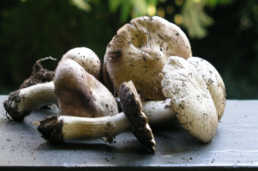
We’re not new to foraging. Back in Connecticut, we found (but kept silent about) a few neighborhood glens where mushrooms spring up after an autumnal rain. At first, we found mostly puffballs and campesters (the wild version of the button mushrooms in every supermarket). Once in a while we collected something that looked like porcini (aka boletus edulis), but were not always 100% sure. And because the margin of error in mushroom identification is slim, we had our share of anxiety until we bought a graphically precise mushroom field guide and met a veteran forager (who, thanks to his Polish DNA, is programmed to hunt for fungi after Labor Day). Soon enough, we were gathering enough mushrooms for a proper dish of pasta alla boscaiola, woodsman’s-style pasta. It was delicious. We felt we had put the ‘bosca’ back in boscaiola.
But since we’ve lived in Sarasota, we’ve been more mycologically challenged. We showed a couple of specimens to a friend who works at Selby Gardens. He studied our find through his loupe and muttered something about pores rather than gills without making a judgement; this did little to bolster our confidence. Needless to say, we changed our dinner plans.
Our fruit foraging has been more productive. Unlike virtually all our neighbors, we don’t own a dog. But whenever we go out for an evening stroll we bring a plastic bag, just in case something delicious has tumbled down to the side of the street. Surinam cherries, loquats, white sapote, calomondins…all edible—and ignored—in our vegetation-blessed neighborhood. Our only competition for this bounty are the local squirrels and less savory fruit rats. Beating them at their game adds a certain frisson to an already pleasant walk.
Certainly oranges have been easy enough to acquire. Even though our own back yard is home to several citrus trees, we do supplement our harvest with occasional evening forays. This is often necessary because the squirrels awaken before us and seem to enjoy starting their day with fresh OJ as much as we do.
One member of this partnership has proposed a rodent resettlement initiative. This would involve a couple of Haveahart traps and an evening drive “out east of I-75.” The plan has not gained unanimous support in our household legislature, so the proposal may have to be reintroduced during the fall fruit session; in any event, our next crop of oranges won’t ripen until November.
On the other hand, grapefruit are abundant for two reasons: 1) Most grapefruit are too large to be hauled off even by the most optimistic squirrel, and 2) half of Sarasota seems to be on Lipitor ®, for which grapefruit consumption is contraindicated.
If you follow food trends, you know that Alice Waters and her chefs at Chez Panisse have put the Meyer lemon on a culinary pedestal. It’s with good reason that this exceptionally juicy and fragrant citrus of low acidity is so prized, and we were thrilled to discover an old Meyer lemon tree on one of our trade routes. On the edge of a lot where a house was to be leveled, it was laden with fruit last year. We were looking forward to another lemon season, and it never occcured to us that after knocking over the house, the developer would also bulldoze every tree on the property! We’re still in mourning.
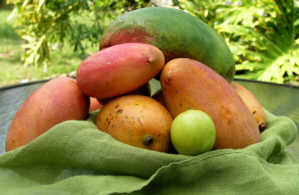
Mango season is in full swing now, and again, we’re astounded that so much fruit is simply lying on the ground. We found one mango that weighed nearly three pounds and dozens of others in the 14-oz. range. Here again, we are in competition with local wildlife. But caveat, fellow foragers! We won’t gorge ourselves on mangoes the way we did last year. One of us is allergic to poison ivy and found that excessive mango intake can trigger an itchy rash—not as discomfitting as poison ivy—but enough to make us look up the botanical family of Anacardiaceae, whose members include cashew, poison ivy, and…mangoes.
Exercising some restraint, we’ve been enjoying mangoes as a simple breakfast salsa. We wash our mangoes and then skin them with a carrot-peeler. We then rinse both the fruit and our hands—the resin from the skin contains most of the chemical allergens. Having cut the flesh into small chunks, we mix it with a little salt, freshly milled black pepper, red pepper flakes, juice from foraged limes, and coarsely chopped Thai basil. That, with some whole-grain toast, is a beautiful breakfast. We sometimes add grated ginger root and lime rind—but the mangoes are so delicious right now that we don’t have to do much.
Jazz at the Airport
August 8th, 2007Sarasota-Bradenton Airport: a Tuesday in August, 11 a.m. The temperature on the tarmac is 94 F. and rising. But inside the arrivals hall there’s a buzz—and it’s coming from something much cooler than air conditioning. For the month of August, arriving passengers (and those waiting to meet them) will be soothed by some of the finest jazz on the Gulf Coast.
Non-aeronautic diversions are nothing new for airports: bookstores, shoe-shine stands, 15-minute massage therapists… SRQ’s stars are swimmers, Mote Marine’s live leopard sharks. But now, the sharks have competition.
Bradenton Area Convention & Visitors Bureau executive director, Larry White is a big jazz fan. So big he has included the cavernous spaces of SRQ as a venue for the Bureau’s “Jazz on the Islands” series.
Twice each day through the entire month of August, from 11:00 a.m.—1:00 p.m. and from 3:30 p.m.—5:30 p.m., incoming passengers will be surprised to hear live jazz played by some of Sarasota’s most sophisticated musicians.
While it’s not yet apparent exactly how airport jazz is being received (a lot of arriving passengers come through talking on their cell phones), we gleaned the following comments between Tom Carabasi’s driving samba beats: “…a lot better than Fort Myers,” and “this place [SRQ] is a country club compared to Tampa.”
Dean of Sarasota jazz pianists and program coordinator, Michael Royal, has enlisted a Who’s Who of local performers. Rick Peterson, Tom Carabasi, Marc Mannino, Mark Neuenschwander, and Gary Goetz will rotate throughout the month, goodwill ambassadors for both arriving and departing passengers. Meanwhile, we defy anyone to find more mellow TSA agents than those at SRQ.
As we get farther into the rainy season here, sudden downpours can douse even the hottest outdoor concerts. So it’s exciting that Larry White’s creative, out-of-the-box thinking has tapped two of our great resources: a pool of extremely talented musicians and our superlative (and underutilized) airport.
Now, let’s figure out a way to perpetuate the program so that high-season travelers can also experience the theraputic benefits of jazz on the concourse.
Sipping at Short-Stop
August 4th, 2007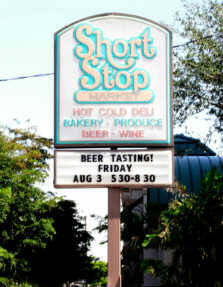
Just a quick note about the unexpected pleasures of a stout and ale tasting at the Short-Stop on Orange Avenue. It may be hard to imagine having an organized tasting of anything more sophisticated than beef jerky at a convenience store. But this is no ordinary convenience store.
The formerly generic, quick-in-and-out Short-Stop now devotes half its floor space to wine, including some very prestigious labels. The beer selection has grown far beyond long-necked Buds. Owner Ali Molavi, has taken his enterprise in new directions and has started to host monthly tastings. Last night, distributor J.J. Taylor was pouring seven distinctive specialty beers.
Though many beer aficionados lack the verbosity of wine tasters, mention of soy, peanut, smoke, espresso and citrus notes were heard. Vocabulary is fostered by connoisseurship, and we think any effort that makes us think about what we eat and drink is good.
The sampling included Wolaver’s Organic Brown Ale from Vermont and Brooklyn Pennant Ale. We were especially taken with the extremely hoppy Two-Heart Ale and the dense, bitter chocolate qualities of Kalamazoo Stout—both from Bell’s of Kalamazoo, Michigan.
Of course, if you want a long-necked Bud and some beef jerky, you can still find them here.
521 South Orange Avenue
Sarasota, Florida
941.955.6881


